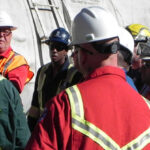
All scaffolding inspection must be carried out by a competent person whose combination of knowledge, training and experience is appropriate for the type and complexity of the scaffold.
All companies using scaffold have a duty to ensure that it is inspected in accordance with statutory requirements and is safe to use at all times.
A scaffold is generally defined as a temporary elevated structure on which persons perform work under legal guidelines.
Reasons why scaffold collapse
- Incorrect scaffold erection
- Overloading
- Uneven distribution of loads
- Poor ground conditions
- Adverse weather conditions
- Insufficient or inappropriate ties
- Incompatible component
- Unauthorized alteration
Who is Responsible for Scaffold Inspection?
It is very important that scaffolds should only be inspected by a competent person with adequate knowledge and experience in scaffold safety.
This person must receive proper scaffold inspection training and experience before being assigned such a crucial task. If this competent person finds an issue within the scaffolding, it is important for him to have the authority to demand that the appropriate safety measures be taken as well.
Work at Height Regulations (2005) Requirements for Scaffold Inspection
- Scaffolds must be inspected before they are used and confirmed in the initial inspection report or in a handover certificate.
- Scaffolds must be inspected every 7 days.
- Scaffolds must be inspected following events which could affect the safety of the structure, e.g. alterations, adverse weather or an earthquake.
- Scaffold inspection reports must be kept in a format which can be reproduced in a printable form and is secure from loss or unauthorised interference.
- The person carrying out a scaffold inspection must prepare a report before the end of the working period within which the inspection is completed and this must be shared with the client / employer within 24 hours.
- An employer receiving a report must keep it at the site where the inspection was carried out until the construction work is completed and then at his/her office for 3 months.
- Protection may be removed but only for the time and to the extent necessary to gain access for the performance of a particular task and shall be replaced as soon as practicable. The task must not be performed unless effective compensatory safety measures are in place.


Information to be Included in a Scaffold Inspection Report:
- The name and address of the person for whom the inspection was carried out
- The location of the inspection
- A description of the scaffold
- The date and time of the inspection
- Details of any matter identified that could give rise to a risk to the health or safety of any person
- Details of any action taken as a result of any matter identified
- Details of any further action considered necessary
- The name and position of the person making the report.

Scaffold Inspection and Handover Certificate
Once a scaffold has been erected, a handover inspection should be completed to check that the scaffold is safe to use. Where written confirmation from a competent person is required, this usually takes the form of a handover certificate.
If alterations, repairs or additions to the scaffold are required a further inspection should be completed and a new handover certificate provided.
The handover certificate should be kept at the workplace until the scaffold has been dismantled.
Scaffold Inspection Tags
All scaffolds shall be inspected and marked with proper identification tags by a competent person. Untagged scaffold should not be used. Scaffold tag should be fastened to the access ladder or near the stairway at the eye level so it is easy to locate.
- Green Tags: Identify scaffolds that are safe for use.

- Yellow Tags: Identify scaffolds which have been modified to meet work requirements, and as a result could present a hazard to the users.

Yellow “Caution” tag indicates special requirements for safe use. It allows the erecting crew to identify which portion of the scaffold is incomplete.
Potential hazard and preventative measures are marked on the back of the tag. The information also contains the name of the client company representative authorizing the use of scaffold.
Yellow tag should not to be removed until the scaffold is safe to use and inspected by a “competent person.”
Based on the results of that inspection, yellow tag should be replaced by appropriate tag (red or green).
- Red Tags: Identify scaffolds that are unsafe for use.

Red tags should have the work order number or project number, inspection date and name of the inspector on the front side.
To ensure personnel are competent to inspect scaffold, Primelift Safety Resources Limited offers scaffold inspection training.
Visit our website: www.primeliftsafetyng.com Email us: training@primeliftsafetyng.com
Call us: +234 9115687051










